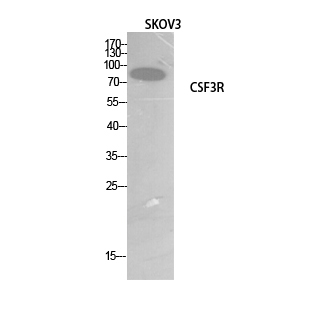G-CSFR Polyclonal Antibody
- Catalog No.:YT5527
- Applications:WB;ELISA
- Reactivity:Human;Mouse
- Target:
- G-CSFR
- Fields:
- >>Cytokine-cytokine receptor interaction;>>PI3K-Akt signaling pathway;>>JAK-STAT signaling pathway;>>Hematopoietic cell lineage;>>Pathways in cancer
- Gene Name:
- CSF3R
- Protein Name:
- Granulocyte colony-stimulating factor receptor
- Human Gene Id:
- 1441
- Human Swiss Prot No:
- Q99062
- Mouse Swiss Prot No:
- P40223
- Immunogen:
- The antiserum was produced against synthesized peptide derived from the Internal region of human CSF3R. AA range:321-370
- Specificity:
- G-CSFR Polyclonal Antibody detects endogenous levels of G-CSFR protein.
- Formulation:
- Liquid in PBS containing 50% glycerol, 0.5% BSA and 0.02% sodium azide.
- Source:
- Polyclonal, Rabbit,IgG
- Dilution:
- WB 1:500 - 1:2000. ELISA: 1:20000. Not yet tested in other applications.
- Purification:
- The antibody was affinity-purified from rabbit antiserum by affinity-chromatography using epitope-specific immunogen.
- Concentration:
- 1 mg/ml
- Storage Stability:
- -15°C to -25°C/1 year(Do not lower than -25°C)
- Other Name:
- CSF3R;GCSFR;Granulocyte colony-stimulating factor receptor;G-CSF receptor;G-CSF-R;CD114
- Observed Band(KD):
- 92kD
- Background:
- The protein encoded by this gene is the receptor for colony stimulating factor 3, a cytokine that controls the production, differentiation, and function of granulocytes. The encoded protein, which is a member of the family of cytokine receptors, may also function in some cell surface adhesion or recognition processes. Alternatively spliced transcript variants have been described. Mutations in this gene are a cause of Kostmann syndrome, also known as severe congenital neutropenia. [provided by RefSeq, Aug 2010],
- Function:
- alternative products:Additional isoforms seem to exist. Experimental confirmation may be lacking for some isoforms,disease:Defects in CSF3R may be a cause of severe congenital neutropenia (SCN) in some patients.,domain:The box 1 motif is required for JAK interaction and/or activation.,domain:The WSXWS motif appears to be necessary for proper protein folding and thereby efficient intracellular transport and cell-surface receptor binding.,function:Receptor for granulocyte colony-stimulating factor (CSF3). In addition it may function in some adhesion or recognition events at the cell surface.,similarity:Belongs to the type I cytokine receptor family. Type 2 subfamily.,similarity:Contains 1 Ig-like C2-type (immunoglobulin-like) domain.,similarity:Contains 5 fibronectin type-III domains.,subunit:Homodimer. The dimeric receptor binds two CSF3 molecules.,tissue specificity:One or several isofor
- Subcellular Location:
- [Isoform 2]: Secreted .; Cell membrane ; Single-pass type I membrane protein .
- Expression:
- One or several isoforms have been found in myelogenous leukemia cell line KG-1, leukemia U-937 cell line, in bone marrow cells, placenta, and peripheral blood granulocytes. Isoform GCSFR-2 is found only in leukemia U-937 cells. Isoform GCSFR-3 is highly expressed in placenta.
- June 19-2018
- WESTERN IMMUNOBLOTTING PROTOCOL
- June 19-2018
- IMMUNOHISTOCHEMISTRY-PARAFFIN PROTOCOL
- June 19-2018
- IMMUNOFLUORESCENCE PROTOCOL
- September 08-2020
- FLOW-CYTOMEYRT-PROTOCOL
- May 20-2022
- Cell-Based ELISA│解您多样本WB检测之困扰
- July 13-2018
- CELL-BASED-ELISA-PROTOCOL-FOR-ACETYL-PROTEIN
- July 13-2018
- CELL-BASED-ELISA-PROTOCOL-FOR-PHOSPHO-PROTEIN
- July 13-2018
- Antibody-FAQs
- Products Images

- Western Blot analysis of SKOV3 cells using G-CSFR Polyclonal Antibody. Secondary antibody(catalog#:RS0002) was diluted at 1:20000



